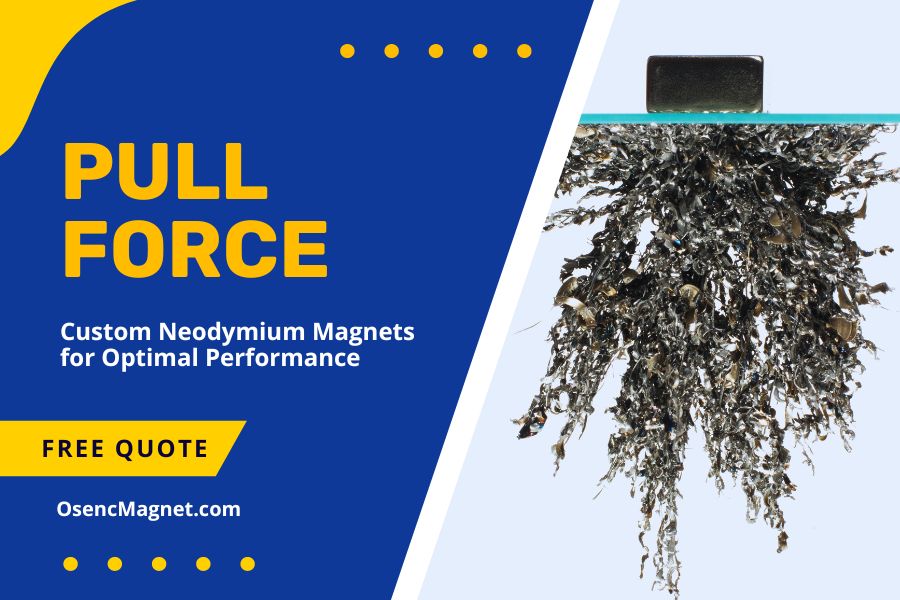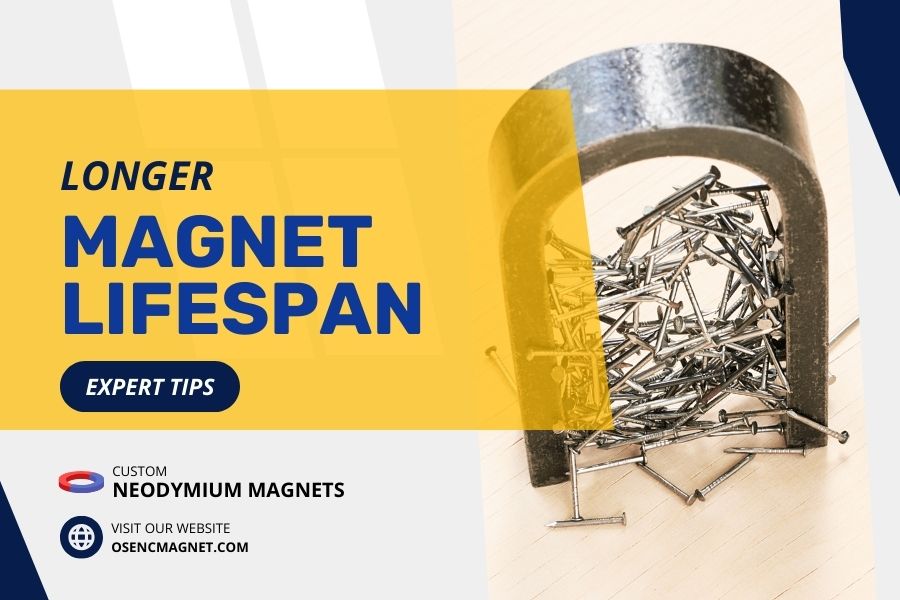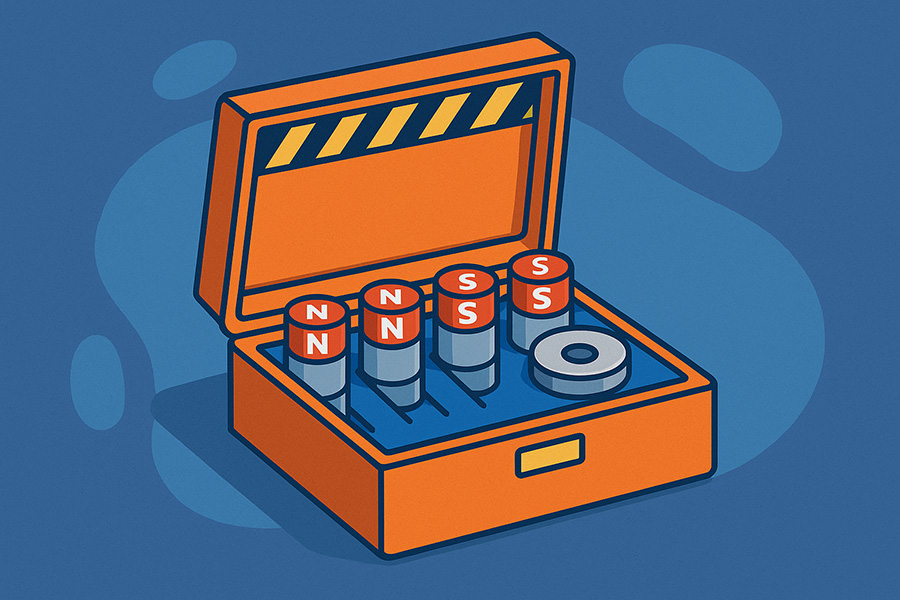The pull force of neodymium magnets is the key to choosing the right magnet for your project.
In this guide, you’ll discover:
- What pull force actually means and how it’s measured
- The science behind magnetic attraction
- Factors that affect a magnet’s strength (and how to maximize it)
- Real-world applications for different magnet sizes
- Common problems and their solutions
- Essential safety tips for handling powerful magnets
This guide will help you understand everything about neodymium magnet pull force.
Let’s get started!
Table of Contents
The Science Behind Magnetic Pull Force
Magnetic Field Basics
Neodymium magnets contain neodymium, iron, and boron (Nd₂Fe₁₄B). This mix creates an incredibly strong magnetic field.
The atoms inside line up in a specific way – scientists call this magnetocrystalline anisotropy. This alignment produces a concentrated magnetic field that extends beyond the magnet.
When this field meets steel, the steel’s atoms become magnetized. This creates the powerful attraction we call pull force.
The strength comes from the magnet’s high magnetization and steep field gradients near its surface.
How Pull Force Works
When you put a neodymium magnet on steel, the magnet’s field makes the steel’s atoms align.
This creates a strong bond between the surfaces.
The strength of this bond depends on the magnet’s grade and size.
Higher grades (like N52) produce stronger pull forces than lower grades (like N35).
Surface area matters too. More contact between magnet and metal creates stronger overall pull.
In physics terms, pull force works like this:
- Pull Force ≈ (B² × Area) ÷ (2μ₀)
Where B is the magnetic flux density and μ₀ is a constant.
This shows why both field strength and contact area are key to pull force.
Measuring Pull Force
Standard Measurement Method
Manufacturers measure pull force in ideal conditions. They place the magnet on a clean, flat mild steel plate thick enough to absorb all the magnet’s field.
A force gauge pulls the magnet away from the steel at a right angle. The peak force just before separation becomes the rated pull force.
This number appears in product specs as “pull force,” “pull strength,” or “holding force.”
Real-World Considerations
Your actual experience might differ from rated values. Several factors can reduce a magnet’s effective pull:
- Surface quality (rough or painted surfaces create tiny air gaps)
- Steel thickness (thin steel reduces pull force dramatically)
- Temperature (heat temporarily weakens magnets)
- Angle of pull (straight pulls achieve maximum force)
- Metal type (cast iron provides only about 60% of the force compared to mild steel)
- Surface flatness (any irregularity creates microscopic gaps)
- Steel permeability (low-carbon steel works best due to high magnetic permeability)
For practical use, expect 30-50% less pull force than the rated value.
Here’s a real example: a magnet rated at 50 lb pull force might only hold about 15 lb when mounted on a vertical surface due to sliding resistance. On thin steel, it might hold even less.
The rated pull is the theoretical maximum in perfect conditions. For real applications, always choose magnets with pull force exceeding your needs.
Factors That Affect Pull Force
Magnet Grade
Neodymium magnets come in different grades like N35, N42, N52. The number shows the magnet’s maximum energy product (BHmax).
A higher number means stronger magnetic properties. An N52 magnet will have greater pull force than an N35 of the same size.
Different uses need different grades. Higher isn’t always better when you consider cost and heat resistance.
Special grades like N42SH can handle higher temperatures (up to 150°C) while standard grades start losing strength around 80°C.
Size and Shape
Size greatly affects pull force. Larger magnets generally pull stronger. Doubling a magnet’s size can roughly double its pull force.
Thickness is crucial too. A thicker magnet concentrates more magnetic flux at the surface. This significantly increases pull strength.
Different shapes distribute force differently:
- Disc magnets focus force at their center
- Block magnets spread force more evenly across their surface
- Pot magnets (magnets in steel cups) redirect the field to one face, maximizing pull
- Ring magnets allow mounting with bolts but have slightly less pull than solid ones
- Horseshoe magnets focus the field on two poles for stable lifting
Air Gaps
Even tiny spaces between magnet and metal dramatically reduce pull force.
The drop follows roughly an inverse square law.
- A gap of just 0.5mm can cut pull force by 50%.
Here’s how gaps affect pull force (approximate percentages of maximum pull):
- Direct contact: 100% pull force
- 0.5mm gap: 50% pull force
- 1mm gap: 25% pull force
- 2mm gap: 10% pull force
- 5mm gap: Less than 5% pull force
For example, a magnet with 50-pound pull in direct contact might hold only about 5 pounds with a 2mm spacer between it and the steel.
Common causes of air gaps include:
- Paint layers (typical wall paint is 0.1-0.2mm per coat)
- Surface coatings (powder coating can be 0.05-0.15mm thick)
- Rust or dirt
- Uneven surfaces
- Microscopic surface irregularities
For maximum strength, direct contact between clean magnet and metal is essential.
Remember:
- Zero gap = maximum pull
- Small gap = much weaker pull
Steel Thickness Matters
The thickness of the steel you’re attaching to significantly affects pull force. If steel is too thin, the magnet’s field “leaks” through instead of contributing to hold.
For example, if a magnet needs 10mm thick steel to reach full pull force, using it on a 1mm sheet might only give you about 10% of the rated force.
Here’s a practical guide:
- For a 10mm diameter magnet: Use steel at least 3mm thick
- For a 25mm diameter magnet: Use steel at least 5mm thick
- For a 50mm diameter magnet: Use steel at least 8mm thick
When the steel is too thin, some of the magnet’s field is wasted. A magnet that delivers 10 kg pull on thick steel might only manage 1 kg on a very thin sheet.
Always check if your application’s steel is thick enough for maximum performance.
Temperature Effects
Neodymium magnets lose strength when heated. Different grades have different maximum operating temperatures.
Standard N grades begin losing strength at around 80°C (176°F). High-temperature grades (like N42SH) can handle up to 150°C (302°F).
This loss is usually temporary unless the magnet exceeds its maximum operating temperature, which can cause permanent demagnetization.
Interestingly, cold temperatures slightly increase magnetic strength. For high-temperature applications, consider samarium-cobalt magnets as alternatives.
Direction of Pull: Vertical vs. Shear Force
When mounting magnets on vertical surfaces, pull force changes dramatically. A magnet can hold only about 20-30% of its rated pull force in a sideways orientation.
For example, a magnet rated for 10kg pull might only support about 2kg when mounted on a vertical steel surface before it slips. This happens because the magnetic force must work against gravity through friction.
- The coefficient of friction for steel-on-steel is approximately 0.2, which explains the significant reduction.
- It’s roughly five times easier to slide a magnet than to pull it straight off.
To improve sideways holding power:
- Add rubber coatings to increase friction (note this creates a small gap)
- Use multiple magnets spread apart for better stability
- Add a mechanical lip or ledge to support some of the weight
- Choose magnets rated for at least 3-5 times your required holding weight
Maximizing Pull Force in Practice
Ensure Direct Contact
The simplest way to maximize pull is to eliminate any gap between magnet and metal. Remove paint, rust, dirt, or anything creating separation.
Even a thin paper sheet (0.1mm) can reduce pull force by 20-30%. A business card (0.3mm) might reduce it by 40%.
Use Flat, Smooth Surfaces
For maximum hold, the entire face of the magnet should make flush contact with the metal surface. Any tilt or point contact drastically cuts force.
Consider machining or polishing contact surfaces for critical applications.
Some users attach a thin piece of soft iron to the magnet face which can “bed” into slightly uneven surfaces.
Match the Right Metal
Low-carbon steel is ideal for magnetic attraction.
Some metals respond differently:
- Mild steel (low carbon): 100% of rated pull force
- Cast iron: About 60% of rated pull
- High-carbon steel: 70-80% of rated pull
- Most stainless steels: 0-20% of rated pull (many are non-magnetic)
- Aluminum, copper, brass: 0% (not magnetic)
Choose Optimal Orientation
Design your application so that the magnet pulls straight away from the surface rather than in shear (sideways).
For a 50kg-rated magnet:
- In direct pull: Close to 50kg holding power
- In shear (on vertical surface): Only about 10-15kg before sliding
- Upside-down (on ceiling): Close to rated pull force if pulling straight down
Special Magnet Configurations
Stacking Magnets
Stacking two identical magnets can roughly double the pull force. This works when magnets are aligned with poles in the right direction (north to south).
Adding more magnets has diminishing returns. Once the stack is thick enough that the steel is fully saturated, extra magnets won’t add much more pull.
It’s critical that stacked magnets have poles aligned correctly. If you place them with like poles facing (north to north), they will repel each other.
Magnetic Assemblies
Specially designed magnetic assemblies can enhance pull force:
- Pot magnets (magnets in steel cups) focus the field on one face, increasing pull force by 20-30%
- Halbach arrays (special pattern of magnet orientation) channel the field to one side
- Magnetic circuits with steel components can direct and concentrate magnetic fields
- Countersunk magnets with pre-drilled holes allow for secure mounting
- Hook magnets (neodymium pot magnets with hooks) are ideal for hanging objects from steel beams
For industrial applications, threaded-back pot magnets offer both strong pull force and convenient mounting options using screws or bolts.
Practical Examples of Pull Force
Small Magnets
A typical 10mm × 3mm N42 disc magnet has a pull force around 2.5kg (25N).
This can hold several sheets of paper to a refrigerator.
Despite its small size, such a magnet can be surprisingly strong.
Handle with care to avoid pinched fingers.
Medium Magnets
A 25mm × 5mm N42 disc magnet offers approximately 11kg (110N) of pull force.
This can hold a small tool to a metal surface.
These medium-sized magnets are versatile for many household and workshop applications.
Large Magnets
A 50mm × 10mm N42 disc magnet delivers about 40kg (400N) of pull force.
This can support significant weight in industrial settings.
Large magnets require careful handling.
Their strength can cause injury if mishandled.
Application-Specific Selection Guide
For Lightweight Holding (Under 2kg)
Small disc magnets (10-15mm diameter) or block magnets (10x10x5mm) work well for:
- Refrigerator magnets
- Magnetic clasps
- Light document holders
- Craft projects
Choose N35 or N42 grade for cost efficiency. For thin steel applications, consider using a larger magnet with moderate strength rather than a tiny, super-strong one.
For Medium-Duty Applications (2-10kg)
Medium-sized magnets (20-30mm diameter) or pot magnets with 20-25mm diameter are suitable for:
- Tool holders
- Cabinet latches
- Door catches
- Signage mounting
N42 grade offers good performance at reasonable cost.
For vertical mounting, select magnets rated for at least 3x your required holding weight.
For Heavy-Duty Industrial Use (10kg+)
Large magnets (40mm+ diameter) or industrial assemblies are needed for:
- Lifting applications
- Machine fixturing
- Heavy equipment mounting
- Industrial separators
For lifting applications, always follow these guidelines:
- Use only specifically designed lifting magnets with proper ratings
- Apply a 3:1 or 4:1 safety factor (for a 100kg load, use magnets rated for 300-400kg)
- Ensure steel thickness meets the magnet’s minimum specification
- Test on similar materials before operational use
- Never exceed 50% of the rated capacity for dynamic loads
For extreme environments, choose specialty magnets:
- High-temperature applications (80-150°C): Use H, SH, or UH grade magnets
- Wet or corrosive environments: Use fully-coated or epoxy-sealed magnets
- Extreme precision needs: Consider machined assemblies with precise tolerances
Simple Ways to Estimate Pull Force
If you need to estimate a magnet’s pull force without complex calculations:
- Use proportions: If you double a magnet’s dimensions, expect roughly four times the pull force (area increases by 4x)
- Test with weights: See what weight a magnet can just barely lift to estimate its pull force
- Consider gaps: Remember that a 1mm gap might reduce pull force to 25% or less of direct contact strength
- Use manufacturer data: Most suppliers provide charts with pull forces for standard sizes
- Quick field test: Make a simple pull-force tester using a luggage scale or fish scale. Attach the magnet to steel, hook the scale to it, and pull perpendicularly until it separates.
For estimating pull force between two magnets (rather than magnet-to-steel), the force is typically 3-4 times less than the rated pull force to steel.
Common Misunderstandings About Pull Force
“Pull Force vs. Holding Power”
These terms mean the same thing – how much weight a magnet can hold under ideal conditions.
Remember that rated pull force applies only to perpendicular pulls, not sideways mounting.
“Stronger Magnet = Holds More at Distance”
Even powerful magnets exert little force at distance.
A 100kg-rated magnet might barely lift a paper clip from several centimeters away.
Always design for minimal gaps.
“All Metals Are Magnetic”
Neodymium magnets only attract ferromagnetic metals (iron, steel, nickel, cobalt).
They won’t stick to aluminum, copper, brass, or most stainless steels.
“North/South Poles Matter for Steel”
For magnet-to-steel attraction, either pole works equally well.
Polarity only matters when two magnets interact with each other.
Performance Troubleshooting
“My magnet isn’t as strong as advertised”
Common causes:
- Air gap present (even microscopic)
- Steel too thin for magnet size
- Steel not fully ferromagnetic
- Magnet pulling at an angle rather than perpendicular
- Temperature too high
- Magnet partially demagnetized from heat exposure
“My magnet worked initially but lost strength”
Possible issues:
- Magnet heated beyond maximum operating temperature
- Physical damage creating internal fractures
- Exposure to strong opposing magnetic fields
- Corrosion on the magnet or contact surface
- Changes in the mounting surface (increased roughness, oxidation)
“My magnet slides down the vertical surface”
Solutions:
- Use a magnet with 3-5x higher pull force rating
- Add a rubber coating to increase friction
- Create a mechanical stop to prevent sliding
- Use multiple magnets positioned strategically
- Choose a pot magnet with rubber covering
Safety Considerations
Strong magnets can pinch skin between them or against metal surfaces. Always handle larger magnets with care.
Neodymium magnets are brittle and can chip or shatter if allowed to snap together.
Always wear eye protection when handling very strong magnets.
When working with magnets over 50kg pull force:
- Keep fingers clear of the space between magnets and metal surfaces
- Use wooden wedges for separation rather than fingers
- Place a cloth over magnets before separation to contain possible chips
- Store with “keeper” pieces (steel plates that connect the poles)
Keep powerful magnets away from electronic devices and magnetic media. They can damage screens, hard drives, and credit cards.
Maintain safe distance from pacemakers and medical devices. Even small magnets can affect pacemakers if placed within 6 inches (15cm).
Children should never play with strong neodymium magnets due to ingestion hazards. Two magnets swallowed separately can attract inside the intestines, causing severe injuries.
For large industrial magnets, consider using:
- Wooden wedges to separate them
- Non-magnetic tongs for movement
- Multiple people for handling very large units
- Proper storage with spacers or “keepers”
When transporting strong magnets, keep them in sturdy containers away from electronics, credit cards, and medical devices.
Need Custom Neodymium Magnets With Optimal Pull Force?
Understanding pull force is crucial for finding the perfect magnet for your application. But why struggle with the selection process alone?
Contact our expert team today for personalized guidance on selecting neodymium magnets with the ideal pull force for your specific project.
Whether you need lightweight magnets for crafting, medium-duty solutions for home applications, or industrial-strength magnets for heavy lifting, we’ll help you find the perfect match.



